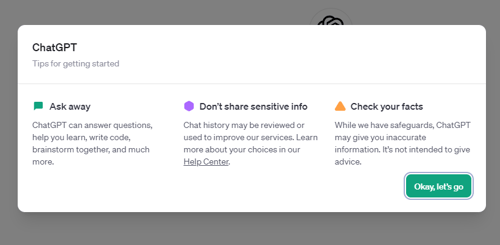.jpg?length=1150&name=ChatGPT%20(2).jpg)
ChatGPT security best practices: A comprehensive guide
Before using ChatGPT or any other AI tools, read this new safety guide. Discover the best practices for using ChatGPT safely and ensuring the security of your conversations. Learn how organisations can implement AI safely to protect sensitive information.
 Why ChatGPT security matters
Why ChatGPT security matters
ChatGPT security is of utmost importance in today's digital world. As an AI language model, ChatGPT has the ability to generate text that is indistinguishable from human-written content. While this is a remarkable achievement, it also raises concerns about the potential misuse of the technology.
Hackers and malicious actors may attempt to exploit vulnerabilities in ChatGPT, leading to various ChatGPT security risks such as spreading misinformation, engaging in phishing attacks, or manipulating individuals into revealing sensitive information. Additionally, cyber attacks leveraging ChatGPT can include advanced phishing campaigns, malware creation, and other malicious activities.
Furthermore, the unfiltered nature of ChatGPT’s responses can result in unintended biases or offensive content, posing significant cyber security challenges. It is essential to address these cyber threats and establish safeguards to ensure the responsible and secure use of ChatGPT.
Language industry trends 2025: What’s next?
6 Best practices for using ChatGPT safely
To use ChatGPT safely, it is recommended to follow these best practices:
1. Verify the source: Ensure that you are interacting with a legitimate instance of ChatGPT provided by OpenAI. Avoid using unofficial or unauthorised web interfaces.
2. Be cautious with personal information: Avoid sharing sensitive personal information, such as passwords, social security numbers, or financial details, when interacting with ChatGPT. Remember that ChatGPT should not be treated as a secure platform for sharing confidential data.
3. Employ content moderation: If you are implementing ChatGPT in a public or customer-facing context, consider implementing content moderation mechanisms to filter out inappropriate or harmful responses. This can help prevent the dissemination of offensive or biased content.
4. Report vulnerabilities: If you come across any potential security flaws or suspicious activities, such as malicious plugins, report them to OpenAI. By doing so, you contribute to the overall security and improvement of the system.
5. Be aware of the potential for attackers to install malicious plugins: Ensure that any plugins used have undergone thorough security reviews to prevent unauthorised installations and critical account takeover vulnerabilities.
6. Copyright Infringement: Ensure that any content generated has been reviewed for copyrighted materials, ChatGPT can generate content that is copyrighted, especially when it comes to novels, etc.
By adhering to these best practices, you can enhance the safety and security of your interactions with ChatGPT.

Protecting sensitive personal information
Protecting sensitive information is crucial when using ChatGPT or any other AI technology. Here are some measures to consider:
1. Ensure end-to-end encryption is enabled: If you need to exchange sensitive information with ChatGPT, ensure that the communication channels are encrypted by checking that the URL is https encrypted. Encryption helps safeguard the confidentiality of the data, making it harder for unauthorised parties to access or intercept.
2. Limit access and permissions: Control access to ChatGPT and restrict permissions to authorised individuals or roles to protect user credentials and minimise the risk of unauthorised access. This minimises the risk of unauthorised access to sensitive conversations or data.
3. Conduct security audits: Periodically assess the security of your ChatGPT implementation through comprehensive security audits. This can help identify and address any potential weaknesses or vulnerabilities in the system.
By implementing these measures, you can strengthen the protection of sensitive information when using ChatGPT.
Ensuring data privacy and cyber security
Data privacy is a critical aspect of using AI, including ChatGPT. To ensure data privacy, consider the following practices:
1. Obtain user consent: When collecting user data for interacting with ChatGPT, obtain informed consent from the individuals involved. Clearly communicate how their data will be used and ensure compliance with relevant privacy regulations.
2. Anonymise and de-identify data: Before sending data to ChatGPT, anonymise and de-identify any personally identifiable information. This helps protect the privacy of individuals whose data is used by the AI model.
3. Secure data storage: Implement robust security measures to protect the storage and transmission of data used by ChatGPT, including the training data that influences the quality of its responses. This includes encryption, access controls, and regular backups to prevent unauthorised access or data breaches.
4. Data retention policies: Establish data retention policies that specify the duration for which user interactions with ChatGPT are stored. Regularly review and delete data that is no longer required to minimise privacy risks.
All data sent to the public version of ChatGPT will be used to improve future models, any information that shouldn't be out in the public domain shouldn't be sent to ChatGPT.
By prioritising data privacy, you can ensure that the use of ChatGPT aligns with ethical and legal standards.

Implementing AI safely in organisations
Organisations can harness the power of AI, including ChatGPT, while ensuring safety and security. Consider the following steps:
1. Develop AI policies: Establish clear policies and guidelines for the use of AI technologies within the organisation. These policies should address security, privacy, and ethical considerations, providing a framework for safe AI implementation.
2. Train employees: Educate employees about the responsible use of AI and the potential risks associated with AI-powered systems like ChatGPT. This includes training on identifying and mitigating security threats, handling sensitive information, and understanding the limitations of AI models. Educate employees about the risk of account takeover on third-party websites like GitHub through plugins that can compromise the organisation's account.
3. Regular risk assessments: Conduct regular risk assessments to identify potential vulnerabilities or misuse of AI systems. This proactive approach allows organisations to address security gaps and implement necessary safeguards.
4. Collaborate with AI experts: Engage AI experts or consultants who specialise in security and privacy to guide the safe implementation of AI technologies. Their expertise can help identify and mitigate potential risks and ensure compliance with industry standards.
By following these steps, organisations can leverage AI safely, fostering innovation while protecting sensitive information and maintaining data security.
OpenAI: What could go wrong with GPT translations?
Conclusion
In contrast to AI-powered tools that may generate inaccurate responses due to error-prone data, GAI, our AI translation solution stands out as a safe, trusted alternative. Trained on meticulously verified multilingual data by human experts, GAI ensures accurate and human-like translations.
This distinction not only sets GAI apart in terms of precision but also empowers users with valuable insights and secure, user-friendly access to their saved translations.
Furthermore, the unfiltered nature of ChatGPT's responses can result in false information, unintended biases or offensive content. It is essential to address these security concerns and establish safeguards to ensure the responsible and secure use of ChatGPT.
Choose GAI for a superior and trustworthy AI experience, start your free trial now.

